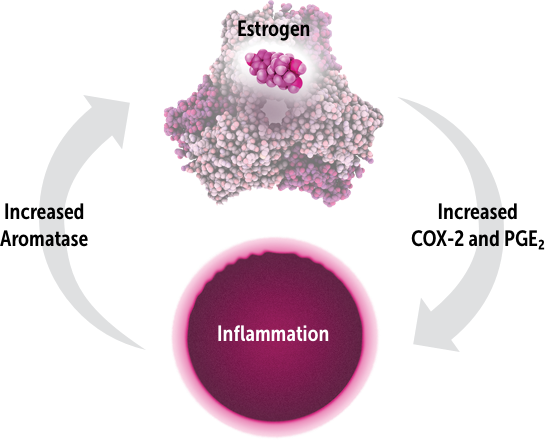Estrogen may cause endometriotic lesions to grow and proliferate over time1-3
Pathophysiology of Endometriosis Pain: Endometriosis is an estrogen-dependent disease and can be progressive2-6
By promoting the proliferation of endometriotic lesions and inflammation throughout the pelvic and abdominal cavity, estrogen fuels the 3 primary types of endometriosis pain1,3,4,7-9
- Dysmenorrhea
- Non-menstrual pelvic pain
- Dyspareunia
The Estrogen-Inflammation Positive Feedback Cycle4

Estrogen induces COX-2 (cyclooxygenase-2), which leads to an overproduction of PGE2 (prostaglandin E2)
The increase in PGE2 directly causes pain and inflammation
PGE2 then stimulates local estrogen production through increased aromatase activity
Endometriosis Grows and Regresses in an Estrogen-Dependent Fashion1
- Estrogen receptors mediate the proliferation of endometriotic tissue in response to increased endogenous estrogen1
- Suppression of estrogen regresses the endometriotic lesions1
- Endometriosis symptoms may be reduced after menopause or with pregnancy10
- Endometriosis is most prevalent in women of reproductive age1
References:
1. Kitawaki J, Kado N, Ishihara H, Koshiba H, Kitaoka Y, Honjo H. Endometriosis: the pathophysiology as an estrogen-dependent disease. J Steroid Biochem Mol Biol. 2002;83(1-5):149-155. 2. Asante A, Taylor RN. Endometriosis: the role of neuroangiogenesis. Ann Rev Physiol. 2011;73:163-182. 3. Practice Committee of the American Society for Reproductive Medicine. Treatment of pelvic pain associated with endometriosis: a committee opinion [published correction appears in Fertil Steril. 2015;104(2):498]. 4. Bulun SE. Endometriosis. N Engl J Med. 2009;360(3):268-279. 5. Mao AJ, Anastasi JK. Diagnosis and management of endometriosis: the role of the advanced practice nurse in primary care. J Am Acad Nurse Pract. 2010;22(2):109-116. 6. Association of Professors of Gynecology and Obstetrics. Diagnosis and Management of Endometriosis: Pathophysiology to Practice. Educational Series on Women's Health Issues. https://pdfs.semanticscholar.org/2f57/078beb656b74691969f0a494021dca8e094f.pdf. Accessed June 10, 2019. 7. Burney RO, Giudice LC. Pathogenesis and pathophysiology of endometriosis. Fertil Steril. 2012;98(3):511-519. 8. De Graaff AA, D’Hooghe TM, Dunselman GA, Dirksen CD, Hummelshoj L, WERF EndoCost Consortium, Simoens S. The significant effect of endometriosis on physical, mental and social wellbeing: results from an international cross-sectional survey. Hum Reprod. 2013;28(10):2677-2685. 9. Bourdel N, Alves J, Pickering G, Ramilo I, Roman H, Canis M. Systematic review of endometriosis pain assessment: how to choose a scale? Hum Reprod Update. 2015;21(1):136-152. 10. Davila GW. Endometriosis Clinical Presentation. Medscape. http://emedicine.medscape.com/article/271899-clinical. Updated July 26, 2018. Accessed June 10, 2019.
